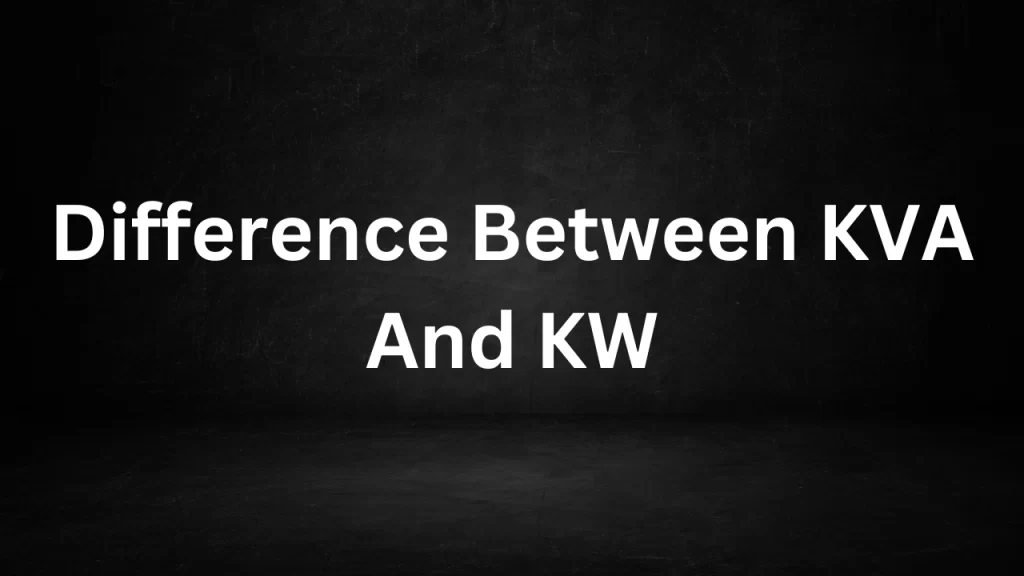Month: August 2023
Kinetic Gas Equation Derivation
Kinetic Gas Equation Derivation: The kinetic gas equation, also known as the ideal gas law, describes the behavior of an ideal gas under various conditions.
It relates the pressure, volume, and temperature of a gas to the number of gas molecules and the ideal gas constant. Here, we’ll outline the derivation of the kinetic gas equation step by step.
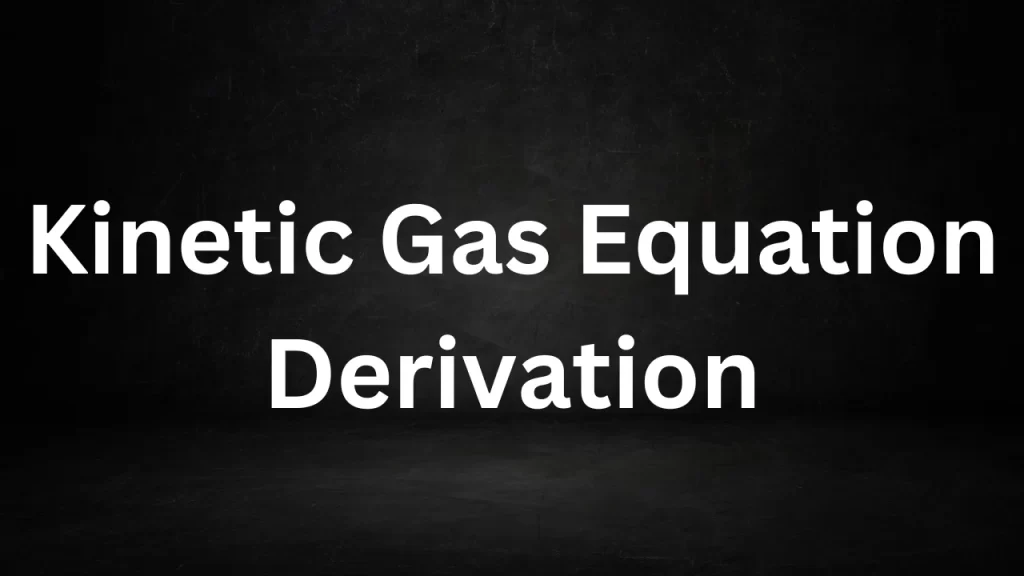
Kinetic Gas Equation Derivation
Step 1: Understanding Assumptions
The ideal gas law is based on several assumptions:
- Gas molecules are considered to be point masses with no volume.
- Gas molecules undergo elastic collisions with each other and the container walls.
- There are no intermolecular forces between gas molecules.
- The volume occupied by the gas molecules themselves is negligible compared to the container’s volume.
Step 2: Defining Pressure and Force
Pressure (P) is defined as force (F) per unit area (A):
P = F/A
Step 3: Force Due to Collisions
Consider a gas molecule colliding with a container wall. The change in momentum during the collision generates a force on the wall. The average force is given by Newton’s second law as:
Where:
- ∆m is the change in momentum of the molecule,
- v_x is the x-component of the velocity of the molecule, and
- ∆t is the time between successive collisions.
Step 4: Relating Force to Pressure
Substituting the force expression into the pressure definition gives:
Step 5: Relating Velocity and Temperature
The average kinetic energy of a gas molecule is proportional to its temperature (T) in Kelvin: 3/2= 1/2
Where:
- k is the Boltzmann constant,
- m is the mass of a gas molecule,
- v is the root-mean-square velocity of the molecules.
Step 6: Substituting Velocity into Pressure Expression
Substitute the expression for velocity (v) from the kinetic energy equation into the pressure equation:
![]()
Step 7: Molecule Count
The number of molecules per unit volume (n/V) is defined as the number density: Where N is the total number of molecules in the volume V.
Step 8: Combining Equations
Substitute the expression for the number density into the pressure equation:
Step 9: Introducing Ideal Gas Constant
The ideal gas constant (R) is defined as:
Step 10: Arriving at the Kinetic Gas Equation
Substitute the ideal gas constant into the equation:
![]()
This equation simplifies to:
![]()
Since 2 is the average kinetic energy ( = 3/2):
This is the kinetic gas equation, also known as the ideal gas law:
Where:
- P is pressure,
- V is volume,
- n is the number of moles of gas,
- R is the ideal gas constant,
- T is temperature.
The kinetic gas equation describes the behavior of ideal gases under various conditions, providing insights into their macroscopic properties based on the motion of their constituent particles.
Read More
- Electromagnetic Waves Transverse Nature Class 10
- Difference Between KVA And KW
- Difference Between LCD And LED
- Electric Potential of a Point Charge Class 10
- Difference Between In Physics
Frequently Asked Question (FEQs)
What is the kinetic gas equation, also known as the ideal gas law?
The kinetic gas equation, often referred to as the ideal gas law, is a fundamental equation in thermodynamics that describes the relationship between the pressure (P), volume (V), temperature (T), and amount of gas (n) in a system. It is represented by the equation PV = nRT, where R is the ideal gas constant.
Why is the ideal gas law also called the kinetic gas equation?
The ideal gas law is sometimes called the kinetic gas equation because it is derived based on the kinetic theory of gases, which considers the motion of gas molecules and their collisions.
What are the assumptions made in the derivation of the kinetic gas equation?
The derivation of the kinetic gas equation is based on the following assumptions:
- Gas molecules are considered to be point masses with no volume.
- Gas molecules undergo perfectly elastic collisions with each other and the container walls.
- There are no intermolecular forces between gas molecules.
- The volume occupied by the gas molecules is negligible compared to the container’s volume.
How does the kinetic gas equation relate pressure, volume, temperature, and the number of gas molecules?
The kinetic gas equation, PV = nRT, establishes a direct relationship between the pressure, volume, temperature, and number of moles of gas in a system. It implies that for a given amount of gas, an increase in temperature or volume results in a proportional increase in pressure.
What role does the ideal gas constant (R) play in the equation?
The ideal gas constant (R) is a proportionality constant that relates the physical properties of a gas to the equation. It provides a bridge between the microscopic behavior of gas molecules and the macroscopic properties described by pressure, volume, temperature, and amount of gas.
Electromagnetic Waves Transverse Nature
Electromagnetic Waves Transverse Nature: Electromagnetic waves are a fundamental aspect of the electromagnetic spectrum, encompassing phenomena such as radio waves, microwaves, visible light, and more.
One of the distinguishing characteristics of electromagnetic waves is their transverse nature, which sets them apart from other types of waves.
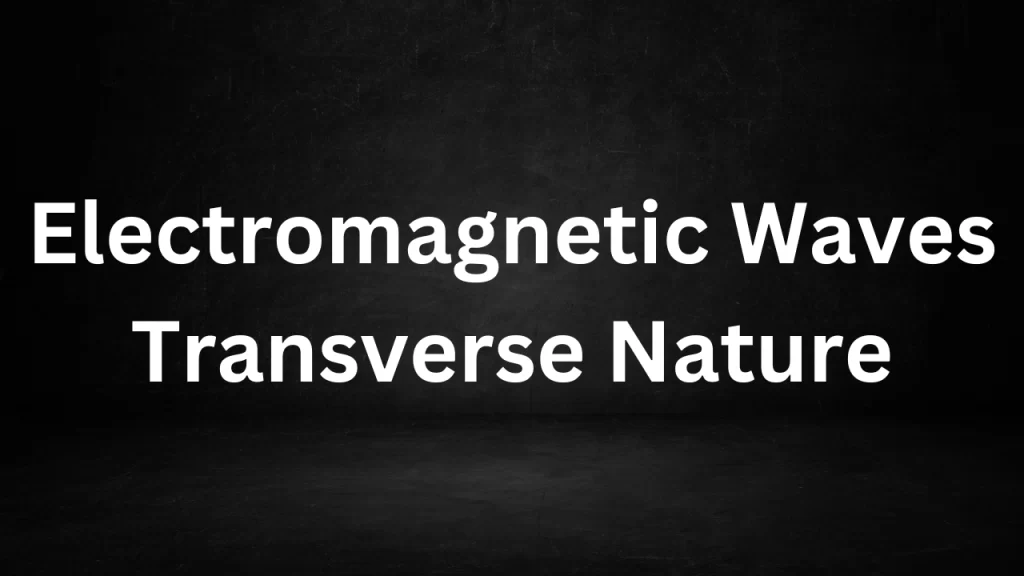
Transverse Waves: A Quick Overview
Transverse waves are a type of wave in which the oscillations of the wave propagate perpendicular to the direction of the wave’s motion. This means that while the wave itself travels in one direction, the individual particles or fields oscillate at right angles to that direction.
Understanding Electromagnetic Waves:
- Electromagnetic Field Oscillations: Electromagnetic waves are composed of electric and magnetic fields that oscillate as the wave propagates. These fields are perpendicular to each other and to the direction of wave motion.
- Perpendicular Oscillations: In an electromagnetic wave, the electric field oscillates in one plane, while the magnetic field oscillates in a plane perpendicular to the electric field. Both fields are orthogonal to the direction of wave propagation.
- Light as an Example: Visible light, which is a form of electromagnetic wave, demonstrates this transverse nature. The oscillating electric and magnetic fields give rise to the characteristic properties of light, such as polarization and interference.
Key Features of Transverse Nature:
- Polarization: The transverse nature of electromagnetic waves allows for polarization. Polarization refers to the orientation of the oscillations of the electric and magnetic fields in a specific direction perpendicular to the wave’s motion.
- Propagation in Empty Space: Electromagnetic waves can propagate through a vacuum, as they do not require a medium for their transmission. This characteristic is a result of their transverse nature.
- Interference and Diffraction: The transverse nature of electromagnetic waves enables them to exhibit interference and diffraction patterns, which are phenomena observed when waves interact with each other or encounter obstacles.
Electromagnetic Waves and Transverse Motion:
- Electric and Magnetic Fields: Electromagnetic waves consist of varying electric and magnetic fields. As the wave travels, these fields oscillate in directions perpendicular to each other and to the direction of the wave.
- Perpendicular Oscillations: The electric field oscillates in a plane perpendicular to the magnetic field, and both are at right angles to the direction of wave propagation. This unique oscillation pattern gives electromagnetic waves their transverse nature.
- Visible Light Example: Consider visible light, a form of electromagnetic wave. The varying electric and magnetic fields give rise to the different colors and properties of light. The transverse oscillations are responsible for phenomena like polarization and color dispersion.
Significance and Characteristics:
- Polarization: The transverse nature allows electromagnetic waves to be polarized. Polarization refers to the alignment of the oscillations in a specific direction. Polarized sunglasses, for instance, filter out certain orientations of light waves to reduce glare.
- Propagation in a Vacuum: Electromagnetic waves can travel through a vacuum, devoid of any material medium. This is due to their transverse nature, which doesn’t require particles to oscillate in the wave’s direction.
- Interference and Diffraction: Transverse waves exhibit interference and diffraction patterns when they interact with each other or encounter obstacles. These patterns result from the superposition of waves with different phases and amplitudes.
Applications:
The transverse nature of electromagnetic waves is at the core of various technological applications, including wireless communication, radio broadcasting, television transmission, and fiber-optic communication. Understanding how these waves oscillate perpendicular to their motion helps engineers and scientists harness their properties for a wide range of purposes.
In summary, the transverse nature of electromagnetic waves is a defining characteristic that governs their behavior, propagation, and applications. This unique feature plays a pivotal role in our ability to communicate, observe the universe, and develop technologies that shape modern society.
Read More
- Kinetic Gas Equation Derivation
- Difference Between KVA And KW
- Difference Between LCD And LED
- Difference Between In Physics
Frequently Asked Question (FAQs)
What does “transverse nature” mean in the context of electromagnetic waves?
In the context of electromagnetic waves, “transverse nature” refers to the perpendicular oscillations of electric and magnetic fields. These oscillations occur at right angles to the direction in which the wave is traveling.
How do the electric and magnetic fields oscillate in electromagnetic waves?
The electric and magnetic fields in electromagnetic waves oscillate perpendicular to each other and to the direction of wave propagation. This perpendicular oscillation gives rise to the unique characteristics of electromagnetic waves.
What is the significance of the transverse nature of electromagnetic waves?
The transverse nature of electromagnetic wave is responsible for various phenomena and applications, such as polarization, interference, diffraction, and the ability to propagate through a vacuum.
How does the transverse nature allow electromagnetic waves to propagate through a vacuum?
Unlike other types of wave that require a medium for propagation, the transverse nature of electromagnetic wave enables them to travel through a vacuum because they don’t rely on the movement of particles for transmission.
What is polarization in the context of transverse electromagnetic waves?
Polarization refers to the alignment of the oscillations of the electric and magnetic fields in a specific direction perpendicular to the wave’s motion. This property has applications in areas like optics and communication.
Energy Stored In A Capacitor
Energy Stored In A Capacitor. A capacitor is an essential component in electronics that stores electrical energy in an electric field.
The energy stored in a capacitor is a direct result of the voltage applied across its terminals and the amount of charge it can hold. The formula to calculate the energy stored in a capacitor is given by:
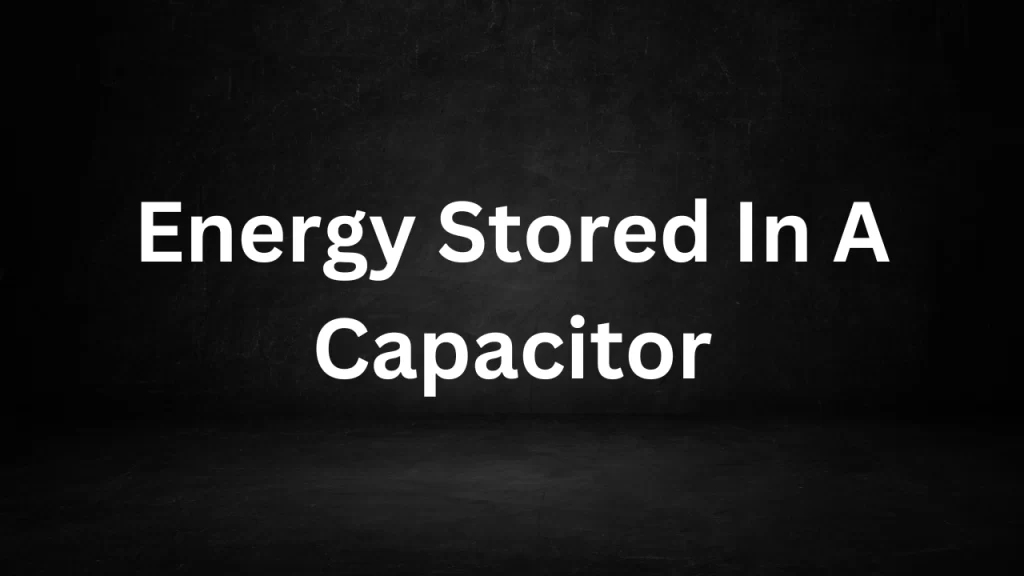
Energy (E) = 0.5 × Capacitance (C) × Voltage (V)^2
Where:
- Energy (E) is the energy stored in the capacitor, measured in joules.
- Capacitance (C) is the measure of a capacitor’s ability to store charge, measured in farads (F).
- Voltage (V) is the potential difference across the capacitor’s terminals, measured in volts.
This formula demonstrates that the energy stored in a capacitor is proportional to the square of the voltage and the capacitance. Capacitors with higher capacitance or higher voltage can store more energy. When a capacitor is charged, it accumulates energy in the electric field between its plates. This stored energy can later be released when the capacitor is discharged.
The energy stored in a capacitor plays a crucial role in various electronic applications, including smoothing voltage fluctuations, filtering signals, and providing bursts of energy in circuits. Understanding how capacitors store and release energy is fundamental in designing efficient and reliable electronic systems.
Energy Stored in a Capacitor: Explained Further
A capacitor, a fundamental component in electronics, is not just about storing charge; it’s also a reservoir of energy in the form of an electric field.
This stored energy becomes vital in various electronic applications, and comprehending its calculation sheds light on the capacitor’s significance.
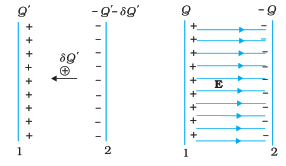
Formula and Components:
The energy stored in a capacitor is directly linked to the voltage across it and the amount of charge it can accumulate. The formula to calculate this energy is:
Energy (E) = 0.5 × Capacitance (C) × Voltage (V)^2
Capacitance (C): This property measures how much charge a capacitor can store for a given voltage. It is measured in farads (F).
Voltage (V): The potential difference between the capacitor’s plates, measured in volts. It’s the driving force behind the energy storage process.
Understanding the Equation:
The formula highlights that energy stored is proportional to both the capacitance and the square of the voltage. This means that doubling the voltage will result in a fourfold increase in energy, while doubling the capacitance will result in a twofold increase.
Energy Storage Process:
When a capacitor is connected to a power source, it charges as it accumulates electric potential energy. The energy is stored as an electric field between the capacitor’s plates.
This field exerts a force on the charges, preventing further accumulation of charge. Once fully charged, the capacitor contains energy that can be released when needed.
Applications:
Filtering and Smoothing: Capacitors are often used to filter out noise and voltage fluctuations from electrical signals, ensuring a stable output.
Energy Storage: In circuits like camera flashes, capacitors can quickly store energy and release it in a burst when needed.
Backup Power: Capacitors can provide temporary power during brief interruptions, allowing systems to shut down safely.
Timing Circuits: In combination with resistors, capacitors are crucial in creating time delays and oscillations in electronic circuits.
Conclusion:
The energy stored in a capacitors exemplifies the interplay between voltage, capacitance, and electric fields. This energy reservoir is pivotal in electronics, contributing to diverse applications that range from signal processing to energy bursts.
Understanding the nuances of energy storage enhances our ability to design efficient and responsive electronic systems.
Read More
Frequently Asked Question (FAQs)
What is the energy stored in a capacitor?
The energy stored in a capacitor refers to the electric potential energy stored in the electric field between its plates when it’s charged.
How is the energy stored in a capacitor calculated?
The energy stored in a capacitors can be calculated using the formula: (E) = 0.5 × Capacitance (C) × Voltage (V)^2.
What is capacitance?
Capacitance is a measure of a capacitor’s ability to store charge for a given voltage. It is measured in farads (F).
How does voltage affect the energy stored in a capacitor?
The energy stored in a capacitors is directly proportional to the square of the voltage applied across its terminals. Doubling the voltage results in a fourfold increase in stored energy.
Can a capacitor store an infinite amount of energy?
No, a capacitor’s energy storage is limited by its capacitance and voltage. It cannot store an infinite amount of energy.
Difference Between KVA And KW
Difference Between KVA And K. While both KVA and KW are utilized to quantify electrical power, there exists a clear distinction between the two. These units serve as power ratings in various measuring instruments to gauge current characteristics.
They are employed to denote power and are represented by the abbreviations “kilovolt amperes” (KVA) and “kilowatts” (KW). In this discussion, we will delve into the dissimilarities between KVA and KW.
kVA (Kilovolt-Ampere):
- kVA is a unit of apparent power in an electrical system.
- It represents the total power (real power and reactive power) consumed by a device.
- It considers both the active power (kW) and the reactive power (kVAR) components.
- Reactive power doesn’t perform useful work but is necessary for the operation of devices like motors and transformers.
- kVA is important for sizing equipment to handle the total power demand, including reactive power.
- It is used to determine the capacity of electrical systems, especially in situations where power factor correction is needed.
kW (Kilowatt):
- kW is a unit of real power in an electrical system.
- It represents the actual power that performs useful work or generates heat.
- kW is the power that is used to perform tasks, such as running appliances, lights, or machinery.
- It is a measure of the rate of energy consumption or production.
- kW is the primary factor in determining electricity bills, as it represents the energy used over time.
- Unlike kVA, kW doesn’t consider reactive power and only deals with the actual power being consumed or produced.
Key Differences:
-
Nature of Power:
- kVA includes both real power (kW) and reactive power (kVAR).
- kW represents only the real power that performs useful work.
-
Usefulness:
- kVA is important for sizing equipment and assessing the total power demand, including reactive power needs.
- kW is used to measure energy consumption or production for billing and evaluating the actual work performed.
-
Importance in Electrical Systems:
- kVA is crucial for determining the capacity of transformers, generators, and other equipment.
- kW is vital for understanding the actual power requirements and energy usage of devices.
-
Power Factor:
- kVA doesn’t consider power factor.
- kW is directly related to power factor, which indicates the efficiency of power usage.
-
Calculation:
- kVA is calculated using the formula: kVA = √(kW² + kVAR²).
- kW is calculated using the formula: kW = Voltage × Current × Power Factor.
-
Usage Examples:
- kVA is used in situations where power factor correction and equipment sizing are required.
- kW is used to assess energy consumption in homes, businesses, and industries.
In summary, while both kVA and kW are units of power, they represent different aspects of electrical systems. kVA considers total power, including reactive power, and is used for equipment sizing, while kW represents real power and is used to measure energy consumption and perform useful work.
Frequently Asked Question (FAQs)
What does kVA stand for?
kVA stands for Kilovolt-Ampere, a unit of apparent power in an electrical system.
What does kW stand for?
kW stands for Kilowatt, a unit of real power in an electrical system.
What is the main difference between kVA and kW?
The main difference lies in the components they represent. kVA includes both real power (kW) and reactive power (kVAR), while kW only represents the real power that performs useful work.
What is the purpose of kVA?
kVA is used to assess the total power demand, including reactive power requirements. It is important for sizing equipment and determining the capacity of transformers, generators, and other electrical devices.
What is the purpose of kW?
kW is used to measure the actual power that performs useful work or generates heat. It is crucial for understanding energy consumption, billing, and evaluating the efficiency of devices.
Changing States Of Matter
Changing States Of Matter The concept of changing states of matter revolves around the fascinating transformations substances undergo when transitioning from one physical state to another.
Matter, which can exist as solids, liquids, and gases, can shift between these states due to alterations in temperature and pressure. Understanding these transitions requires delving into the behavior of particles at the molecular level.

States of Matter:
- Solid State: In the solid state, particles are tightly packed and maintain a fixed arrangement. They vibrate in place due to their low energy levels. Solids have a defined shape and volume.
- Liquid State: In liquids, particles have more freedom to move. They are still relatively close together, allowing them to slide past each other. Liquids take the shape of their container and have a definite volume.
- Gaseous State: Gases have the highest energy levels among the three states. Particles in gases are widely spaced and move freely. Gases lack a fixed shape or volume and expand to fill their container.
Energy and Transitions:
Changing states of matter primarily involve the transfer of thermal energy. Adding energy to a substance causes its particles to gain kinetic energy, increasing their motion and interactions. Conversely, removing energy results in decreased motion and interactions.
Transitions Explained:
- Melting: When a solid is heated, it gains energy. At a specific temperature known as the melting point, the particles’ kinetic energy becomes strong enough to break the bonds that hold them in a fixed structure. The substance transitions from a solid to a liquid.
- Freezing: Conversely, when a liquid is cooled, it loses energy. As the particles lose kinetic energy, their motion slows down, allowing attractive forces between them to bring them closer together. The substance transitions from a liquid to a solid through freezing.
- Evaporation and Boiling: In a liquid, particles have varying kinetic energies. Some particles at the surface with higher energy can overcome the attractive forces and enter the gas phase. This process, called evaporation, gradually occurs at any temperature. Boiling, however, is rapid vaporization that happens at a specific temperature (boiling point) throughout the liquid.
- Condensation: When a gas loses energy (often through cooling), its particles slow down and come closer together. This allows attractive forces to take over, and the gas transitions into a liquid through condensation.
- Sublimation and Deposition: Sublimation involves the direct transition of a solid into a gas without passing through the liquid state. Deposition is the reverse process, where gas particles lose energy and transition directly to a solid.
Changes in States of Matter: A Deeper Exploration
The world around us is in a constant state of flux, and one of the most intriguing aspects is the changing states of matter. These transitions, from solid to liquid, liquid to gas, and vice versa, are not mere random occurrences but intricate processes driven by the interactions between particles and the energy they possess.
Kinetic Theory and Particle Behavior:
At the heart of understanding changing states of matter lies the kinetic theory. This theory explains the behavior of particles in different states:
Solids: In solids, particles are tightly packed and exhibit minimal movement. They vibrate in place due to thermal energy, but their positions remain relatively fixed.
Liquids: Liquid particles have more energy than their solid counterparts. They can move around, sliding past each other. This mobility allows liquids to flow and take the shape of their containers.
Gases: Gas particles possess the most energy, leading to rapid and chaotic movement. They are widely spaced and have the freedom to move in all directions.
Energizing Transitions:
Melting and Freezing: When you heat a solid, you’re infusing energy into its particles. As they gain kinetic energy, they overcome their fixed positions, and the solid turns into a liquid in a process called melting. Conversely, cooling a liquid causes particles to lose energy. They slow down and arrange themselves in a fixed pattern, forming a solid through freezing.
Evaporation and Condensation: In a liquid, particles with higher energy are at the surface. Evaporation occurs when these energetic particles escape the attractive forces of the liquid and become a gas. Condensation, the reverse process, takes place when gas particles lose energy and revert to the liquid state.
Boiling: Boiling is an intense form of evaporation that happens throughout the liquid. It occurs when the vapor pressure of the liquid matches the atmospheric pressure.
Sublimation and Deposition: Some substances, like dry ice (solid carbon dioxide), can transition directly from a solid to a gas without passing through the liquid phase, a phenomenon known as sublimation. The reverse process, deposition, involves gas turning directly into a solid.
Energy Source: Thermal Energy:
In most cases, thermal energy in the form of heat drives these changes. The more thermal energy particles have, the faster they move and the farther they spread apart. This energy disrupts the attractive forces between particles, enabling them to change states.
Applications and Significance:
Understanding these state changes is essential in various fields. It’s the basis for weather phenomena like clouds and rain, industrial processes like distillation, and even our day-to-day experiences, like the feeling of warmth when wet clothes dry on a sunny day.
Read More
- Average Speed And Average Velocity Class 9
- Differences Between Acceleration And Velocity
- Matter In Our Surroundings Class 9 Summary
- Class 9th Chapter 2 Science Question Answer of NCERT
- NCERT Physics Class 9 Chapter 1 Solutions PDF Download
Conclusion:
Changing states of matter illustrate the dynamic nature of substances and the impact of energy on their behavior. These transitions play a pivotal role in our understanding of various natural phenomena and technological applications, from the water cycle to industrial processes.
Frequently Asked Question (FAQs)
What are the different states of matter?
Matter exists in three primary states: solid, liquid, and gas. These states are characterized by the arrangement and movement of particles within the substance.
How do substances change from one state to another?
Substances change from one state to another by gaining or losing energy. This energy exchange, often in the form of heat, affects the motion and interactions of particles, causing them to transition between states.
What happens during melting and freezing?
Melting is the process in which a solid substance gains enough energy to overcome the forces holding its particles together, resulting in the transition to a liquid state. Freezing, on the other hand, occurs when a liquid loses enough energy to slow down its particles, leading to a transition to a solid state.
What is evaporation, and how does it differ from boiling?
Evaporation is the gradual conversion of liquid particles into gas due to the high-energy particles at the surface escaping the liquid’s attractive forces. Boiling is a rapid form of evaporation that occurs throughout the liquid and requires the liquid’s vapor pressure to match the atmospheric pressure.
Can gases change directly into solids or vice versa?
Yes, this phenomenon is known as sublimation and deposition. Sublimation involves a solid changing directly into a gas without passing through the liquid state. Deposition is the reverse process, where gas particles lose energy and transition directly to a solid.
Difference Between LCD And LED
Difference Between Lcd And Led. LCD (Liquid Crystal Display) and LED (Light Emitting Diode) are two common types of display technologies used in various electronic devices. While they both serve the purpose of displaying visual content, they have distinct differences in how they function and produce images.
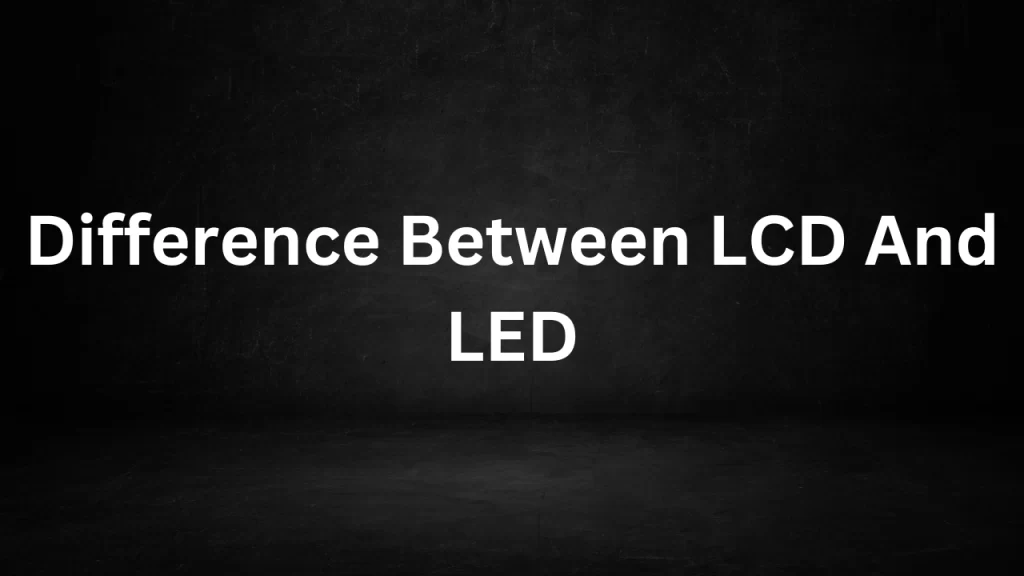
Technology:
- LCD: An LCD screen utilizes liquid crystal molecules to control the passage of light through the display. These molecules can change orientation when an electric current is applied, allowing or blocking light to create images.
- LED: An LED screen uses an array of light-emitting diodes to produce light directly. Each diode emits its own light, contributing to the overall illumination of the display.
Light Source:
- LCD: LCD screens require an external light source, often referred to as a backlight, to illuminate the liquid crystal display and make the images visible.
- LED: LED screens do not require a separate backlight, as the individual LEDs themselves emit light. This leads to better control over brightness and contrast.
Energy Efficiency:
- LCD: LCD screens are generally less energy-efficient compared to LED screens because the backlight needs to be on continuously, even in dark areas of the image.
- LED: LED screens are more energy-efficient since each LED can be independently controlled. This allows for dimming or turning off specific areas of the screen, reducing power consumption.
Thinness and Flexibility:
- LCD: Traditional LCD screens tend to be thicker and less flexible due to the need for a separate backlight layer.
- LED: LED screens can be thinner and more flexible since the LEDs themselves emit light, eliminating the need for a backlight.
Picture Quality:
- LCD: LCD screens can experience issues like motion blur and limited viewing angles due to the response time of liquid crystals and the need for a backlight.
- LED: LED screens generally offer better picture quality with improved contrast, brightness, and color accuracy. They also have faster response times and wider viewing angles.
Cost:
- LCD: LCD screens are often more cost-effective to manufacture, which has contributed to their widespread use in various devices.
- LED: LED screens were initially more expensive to produce due to the advanced technology involved, but their cost has decreased over time as technology has improved.
Types of LED Displays:
- LCD: LCD displays can also use LED backlighting, known as LED-LCD displays. This combines the liquid crystal technology of LCD with LED backlighting for improved energy efficiency and picture quality.
- LED: LED displays can refer to screens that use individual LEDs to emit light, often seen in large outdoor displays or signage.
In conclusion, LCD and LED are two distinct display technologies, each with its own advantages and disadvantages.
LED technology has largely become dominant due to its superior energy efficiency, picture quality, and flexibility, but LCD screens are still prevalent and can be found in many devices, especially when combined with LED backlighting.
Read More
- Electric Potential of a Point Charge Class 10
- Difference Between In Physics
- Electric Charge And Static Electricity Class 10
- Class 6 Maths Question Paper With Solutions NCERT PDF
- Sample Question Paper For Class 6 CBSE English Grammar
Frequently Asked Questions (FAQs)
What is the main difference between LCD and LED displays?
The main difference lies in the way they produce light. LCD (Liquid Crystal Display) screens use liquid crystals to control light passage, while LED (Light Emitting Diode) screens use arrays of light-emitting diodes to emit light directly.
Do LED displays have better picture quality than LCD displays?
Yes, generally LED displays offer better picture quality. (Light Emitting Diode) displays often have better contrast, brightness, color accuracy, and faster response times compared to traditional LCD displays.
Why are LED displays considered more energy-efficient?
LED displays are more energy-efficient because they can independently control each LED pixel’s light output. This allows for dimming or turning off specific areas of the screen, reducing overall power consumption.
Are all LED displays completely self-illuminating?
No, not all LED displays are self-illuminating. LED-LCD displays use LED backlighting to illuminate the liquid crystal display, which combines LED technology with the traditional LCD structure.
Are LED displays thinner than LCD displays?
(Light Emitting Diode) displays can be thinner compared to traditional (Liquid Crystal Display) displays because they don’t require a separate backlight layer. However, the thickness can also depend on the specific design and purpose of the display.
Average Speed And Average Velocity
Average Speed And Average Velocity In the realm of physics, both average speed and average velocity are concepts used to describe motion. Despite their similarities, they have distinct meanings and implications.
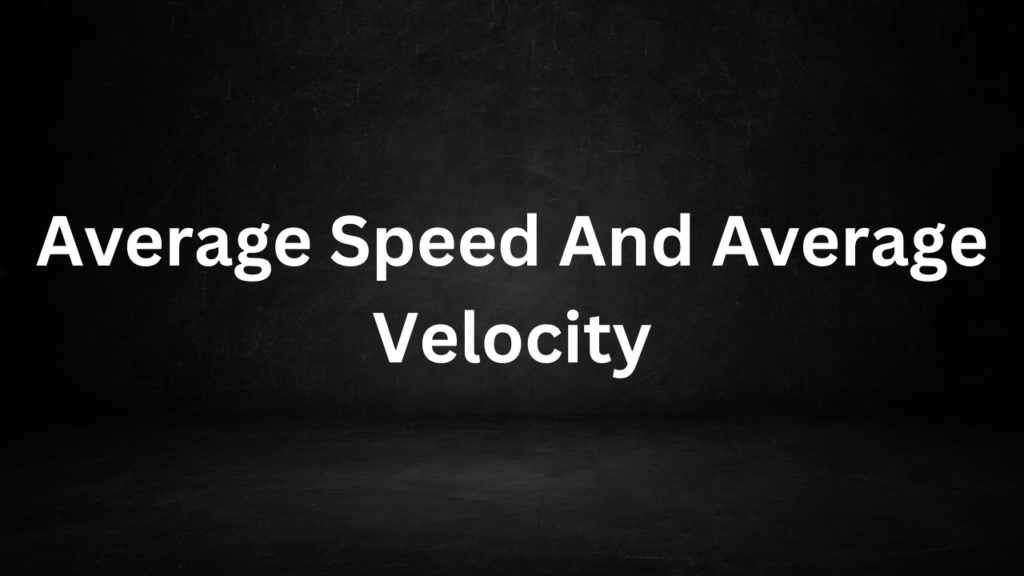
Average Speed:
Average speed is a scalar quantity that measures the overall rate at which an object covers distance during its entire journey. It is calculated by dividing the total distance traveled by the total time taken. The formula for average speed is:
Average Speed=Total Distance Total Time
Average speed provides an overview of how fast an object moves on average, without considering its direction. For instance, if a car travels 200 kilometers in 4 hours, its average speed would be 50 kilometers per hour (km/h).
Average Velocity:
Average velocity is a vector quantity that combines both the magnitude (speed) and direction of an object’s displacement over a specific time interval. It is the change in position divided by the change in time. The formula for average velocity is:
Average Velocity=Displacement Time Interval
Unlike average speed, average velocity considers the displacement of an object from its initial position to its final position. If a person moves 50 meters eastward and then returns 30 meters westward in 10 seconds, their average velocity would be 50 m−30 m10 s=2 m/s to the east.
Key Differences:
- Scalar vs. Vector: Average speed is a scalar quantity that only involves magnitude, while average velocity is a vector quantity that incorporates both magnitude and direction.
- Consideration of Direction: Average speed does not consider direction, whereas average velocity takes both direction and magnitude into account.
- Example: Imagine a car moving in a circular path. If the car returns to its starting point after some time, its average speed over that time might be significant, but its average velocity will be zero because the displacement is zero.
In conclusion, average speed characterizes the overall rate of motion without considering direction, while average velocity provides a more comprehensive picture by including both the direction and magnitude of displacement.
Both concepts are vital tools for describing and understanding the complexities of motion in physics.
Vector Nature:
The vector nature of average velocity makes it a more comprehensive representation of motion. It conveys not only how far something has traveled but also the path it took to get there. This is crucial when you’re interested in the object’s overall movement pattern.
Constant Speed vs. Changing Speed:
Average speed doesn’t differentiate between segments of motion with varying speeds. For example, if a car travels at 30 km/h for half the journey and 60 km/h for the other half, its average speed is 45 km/h (total distance divided by total time).
On the other hand, average velocity accounts for changes in speed and direction, giving you a better understanding of how the object moves overall.
In essence, while both average speed and average velocity offer insights into motion, their considerations of direction and displacement set them apart. The choice of which to use depends on the specific context and what aspects of motion you’re seeking to understand.
Read More
- Differences Between Acceleration And Velocity
- Matter In Our Surroundings Class 9 Summary
- Class 9th Chapter 2 Science Question Answer of NCERT
- NCERT Physics Class 9 Chapter 1 Solutions PDF Download
- CBSE Previous Year Question Papers Class 9 Science
Frequently Asked Questions – FAQs
What is the difference between average speed and average velocity?
Average speed is a scalar quantity that represents the total distance traveled divided by the total time taken, without regard to direction. Average velocity is a vector quantity that accounts for both the displacement and direction of an object’s motion over a specific time interval.
Can average speed be greater than average velocity?
Yes, average speed can be greater than average velocity. This can occur when an object covers a considerable distance in a given time interval, but its overall displacement is relatively small or zero due to changes in direction.
Is the magnitude of average velocity always equal to average speed?
Not necessarily. While the magnitude of average velocity (absolute value) can be equal to average speed in cases where motion is unidirectional, it can differ when there are changes in direction during the motion.
What does a negative average velocity signify?
A negative average velocity indicates that the object has moved in the opposite direction of its initial reference point. It signifies that the displacement has occurred in the negative direction of the coordinate system.
How is average velocity calculated when the direction changes?
When the direction changes, you need to consider the total displacement, not just the total distance traveled. Calculate the difference between the initial and final positions, and then divide it by the total time taken.
Electric Potential of a Point Charge Class 10
Electric Potential of a Point Charge Electric potential, also known as voltage, is a fundamental concept in electromagnetism that describes the amount of electric potential energy carried by a charged particle due to its position relative to other charges.
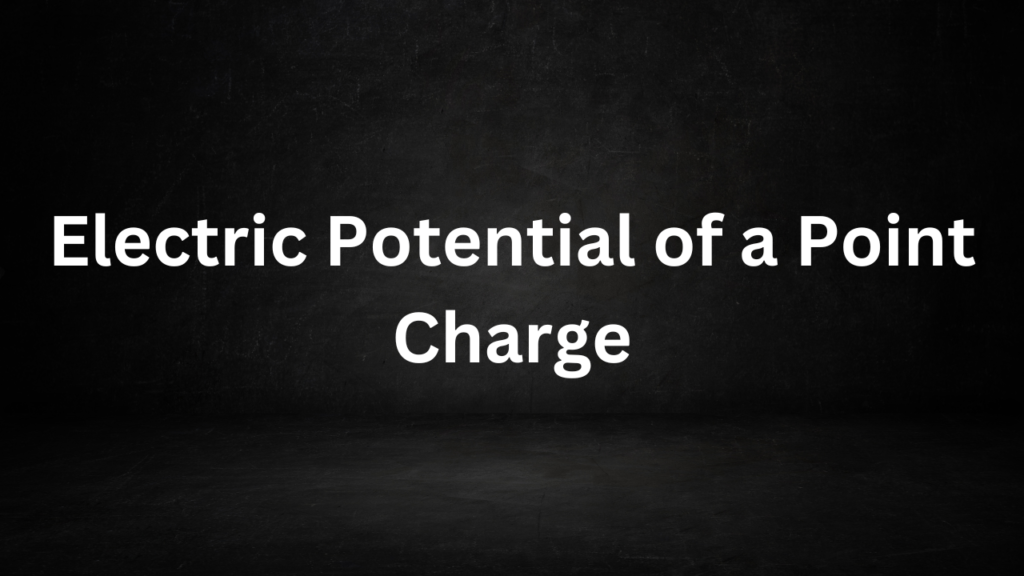
Electric Potential of a Point Charge Class 10
When dealing with a point charge, which is a theoretically charged particle with infinitesimal size, we can calculate its electric potential at a certain distance from it.
The electric potential at a distance from a point charge can be calculated using the formula:
Where:
- is the electric potential at the given point (in volts, V).
- is Coulomb’s constant (8.988×109 N m2/C2 in SI units).
- is the magnitude of the point charge (in coulombs, C).
- is the distance from the point charge to the point where electric potential is being calculated (in meters, m).
This formula tells us that the electric potential at a point decreases as we move farther away from the point charge. It is important to note that electric potential is a scalar quantity, meaning it only has magnitude and no direction.
The unit of electric potential is the volt (V), which is equivalent to one joule per coulomb (1 J/C). This unit reflects the fact that electric potential energy is measured in joules and charge is measured in coulombs.
In summary, the electric potential of a point charge is a measure of the electric potential energy carried by the charge at a specific distance from it. It provides insight into the behavior of charged particles in electric fields and plays a crucial role in understanding various electrical phenomena.
Calculating Electric Potential from a Point Charge:
To understand how the formula for electric potential of a point charge works, let’s break it down further.
Consider a positive point charge located at the origin (0, 0, 0) in a three-dimensional Cartesian coordinate system. We want to find the electric potential at a point located at coordinates .
The electric potential at point due to the point charge is given by:
Where is the distance between point charge and point , given by:
![]()
Substituting this value of back into the electric potential formula, we get:
This formula shows that the electric potential at point is inversely proportional to the distance from the point charge . As the distance increases, the electric potential decreases.
Significance of Electric Potential:
The concept of electric potential is valuable in various practical applications and theoretical understandings:
- Work Done by Electric Forces: The electric potential energy of a charge in an electric field is related to the work done by the electric force when the charge is moved between two points. Specifically, the work done on a charge when moving it from point to point is given by , where and are the electric potentials at points and respectively.
- Equipotential Surfaces: Points that have the same electric potential form an equipotential surface. No work is required to move a charge along an equipotential surface since the potential remains constant. Electric field lines are always perpendicular to equipotential surfaces.
- Capacitors and Circuits: The concept of electric potential is essential in understanding how capacitors store electric energy and how circuits function. The potential difference across a capacitor determines the stored charge.
- Voltage Sources: In electronics, voltage sources such as batteries provide a potential difference that drives the movement of charges through a circuit, enabling the flow of electric current.
- Electrostatic Potential Energy: Electric potential energy is closely related to electric potential. The change in potential energy of a charge moving in an electric field is the product of its charge and the change in electric potential.
In essence, the electric potential of a point charge is a foundational concept in electromagnetism, serving as a key component in explaining and predicting the behavior of charges and electric fields in various contexts.
Relationship Between Electric Potential and Electric Field
The relationship between electric potential and electric field is a fundamental concept in the study of electromagnetism. Understanding this relationship helps explain how charges interact and how electrical phenomena occur.
Here’s an overview of the relationship between electric potential (V) and electric field (E):
The electric field and electric potential are related by the gradient (spatial derivative) of the electric potential. Mathematically, this relationship is expressed as: ,
where:
- is the electric field vector,
- is the gradient of the electric potential.
This equation indicates that the electric field points in the direction of the steepest decrease of the electric potential. In other words, charges tend to move from higher to lower electric potential regions.
Read More
- Difference Between In Physics
- Electric Charge And Static Electricity Class 10
- Class 6 Maths Question Paper With Solutions NCERT PDF
- Sample Question Paper For Class 6 CBSE English Grammar
- CBSE Class 8 Science Sample Paper Set 1 Solution
frequently asked questions (FAQ)
What is electric potential?
Electric potential, also known as voltage, is a scalar quantity that describes the electric potential energy per unit charge at a certain point in an electric field. It is a measure of the work done to move a positive test charge from infinity to that point, divided by the magnitude of the test charge.
What is a point charge?
A point charge is a hypothetical charged particle with no physical size, meaning its charge is concentrated at a single point. It serves as a simplified model to understand how electric charges interact in certain situations.
How is the electric potential of a point charge calculated?
The electric potential () at a distance () from a PC () is calculated using the formula: Where is Coulomb’s constant and is approximately 8.988×109 N m2/C2.
What is Coulomb’s constant?
Coulomb’s constant () is a proportionality constant that appears in Coulomb’s law, which describes the force between two point charges. It is used in various electrostatic calculations and is related to the permittivity of free space.
How does electric potential change with distance from a point charge?
Electric potential decreases as you move farther away from a point charge. This is because the electric potential energy decreases with increasing distance, and the potential is the potential energy per unit charge.
Difference Between In Physics: Comparisons Article
Difference Between In Physics Physics, the fundamental science that seeks to understand the natural world and its underlying principles, often involves comparing and contrasting various concepts to uncover their distinctions. Here are some notable differences between key concepts in physics:

Difference Between In Physics
Distance vs. Displacement:
- Distance refers to the total length of the path traveled by an object. It is a scalar quantity and is always positive.
- Displacement is the change in position of an object from its initial point to its final point, considering direction. It is a vector quantity and can be positive, negative, or zero.
Speed vs. Velocity:
- Speed is the rate of change of distance traveled by an object. It is a scalar quantity and only considers magnitude.
- Velocity is the rate of change of displacement. It is a vector quantity that includes both magnitude and direction.
Mass vs. Weight:
- Mass is the amount of matter in an object and remains constant regardless of location. It is measured in kilograms.
- Weight is the force exerted on an object due to gravity. It depends on both the mass of the object and the gravitational acceleration and is measured in newtons.
Accuracy vs. Precision:
- Accuracy refers to how close a measured value is to the true or accepted value.
- Precision relates to the consistency or reproducibility of repeated measurements. It indicates how closely measurements agree with each other.
Kinetic Energy vs. Potential Energy:
- Kinetic Energy is the energy an object possesses due to its motion. It depends on the mass and velocity of the object.
- Potential Energy is the energy stored in an object due to its position or state. It includes gravitational potential energy, elastic potential energy, etc.
Conduction vs. Convection vs. Radiation:
- Conduction is the transfer of heat through direct contact between particles of a substance.
- Convection is the transfer of heat through the movement of fluids (liquids or gases).
- Radiation is the transfer of heat through electromagnetic waves, such as infrared radiation.
AC (Alternating Current) vs. DC (Direct Current):
- AC is an electric current that periodically reverses direction. It is commonly used in household electricity and power transmission.
- DC is an electric current that flows in one direction. It is often used in batteries and electronic devices.
Wave vs. Particle Duality:
- The wave-particle duality concept in quantum phy states that particles like electrons and photons can exhibit both wave-like and particle-like behavior, depending on the experimental setup.
Understanding these differences is crucial for grasping the nuances of various physical phenomena and their applications in the real world.
Difference between Physics and Applied Physics
Phy and applied physics are related fields, but they differ in their focus, scope, and practical applications. Here’s a breakdown of the distinctions between these two disciplines:
1. Nature of Study:
- Physics: Physics is the fundamental science that seeks to understand the fundamental laws and principles governing the universe. It aims to uncover the underlying theoretical concepts and phenomena.
- Applied Physics: Applied physics, on the other hand, takes the principles and theories of phy and applies them to practical real-world problems and technological advancements.
2. Focus:
- Physics: Physics focuses on studying the fundamental aspects of nature, such as the behavior of matter, forces, energy, and the fundamental particles that make up the universe.
- Applied Physics: Applied physics focuses on using the insights gained from physics to solve specific technological challenges and develop new technologies.
3. Research and Theory:
- Physics: Physics research often delves into theoretical concepts, mathematical models, and fundamental discoveries. It seeks to expand our understanding of the universe’s basic nature.
- Applied Physics: Applied physics research aims to bridge the gap between theory and practical applications. It involves using physics concepts to develop new devices, materials, and technologies.
4. Practical Applications:
- Physics: While physics has led to numerous technological advancements, its primary focus is not necessarily on immediate practical applications but rather on understanding the fundamental laws of nature.
- Applied Physics: Applied physics directly contributes to the development of technologies that have tangible applications, such as lasers, semiconductors, medical imaging devices, and renewable energy technologies.
5. Career Paths:
- Physics: Physics graduates often pursue careers in academia, research institutions, or theoretical research, contributing to the advancement of knowledge.
- Applied Physics: Graduates in applied physics typically find employment in industries such as engineering, electronics, optics, materials science, and other technology-driven sectors.
Advantages of Differences & Comparisons Articles in Physics:
Questions involving distinctions and comparisons are frequently encountered in most physics examinations. Presenting these variances and parallels in a tabular format significantly enhances comprehension, facilitating more effective learning for students.
These articles play a pivotal role in providing students with a comprehensive grasp of the respective subjects. The tabular arrangement provided herein also offers students a more adept way to retain key points, promoting enhanced and efficient understanding.
Read More
- Electric Charge And Static Electricity Class 10
- Class 6 Maths Question Paper With Solutions NCERT PDF
- Sample Question Paper For Class 6 CBSE English Grammar
- CBSE Class 8 Science Sample Paper Set 1 Solution
Frequently Asked Questions (FAQs)
What is the difference between distance and displacement in phy ?
- Distance is the total length of the path traveled by an object, measured in scalar units (e.g., meters). It is always positive and doesn’t consider direction.
- Displacement is the change in position of an object from its initial point to its final point, including direction. It is a vector quantity and can be positive, negative, or zero.
How do speed and velocity differ?
Speed is the rate of change of distance and is a scalar quantity, only indicating magnitude.
Velocity is the rate of change of displacement and is a vector quantity, considering both magnitude and direction.
What distinguishes mass from weight in physics?
Mass is the amount of matter in an object and remains constant regardless of location. It is measured in kilograms (kg).
Weight is the force exerted on an object due to gravity and varies with location. It is measured in newtons (N) and depends on both mass and gravitational acceleration.
What is the difference between accuracy and precision?
Accuracy relates to how close a measured value is to the true or accepted value.
Precision refers to the consistency of repeated measurements and how closely they agree with each other.
How do kinetic energy and potential energy differ?
Kinetic Energy is the energy an object possesses due to its motion and depends on mass and velocity.
Potential Energy is the energy stored in an object due to its position or state, including gravitational potential energy and elastic potential energy.
Electric Charge And Static Electricity Class 10
Electric Charge And Static Electricity: Certainly, I’d be happy to provide a more detailed explanation of electric charge and static electricity.
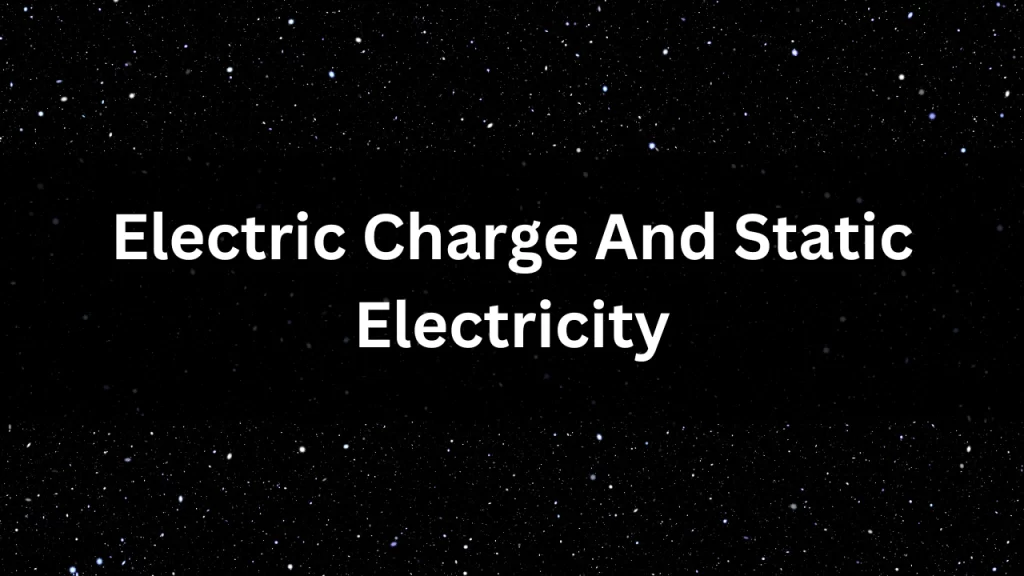
Electric Charge And Static Electricity
Definition of Electric Charge:
The Electric charge is a fundamental property of subatomic particles, such as electrons and protons. It is a property that gives rise to electromagnetic interactions between particles. There are two types of electric charge:
Positive Charge:
This is the type of charge that protons possess. Protons have a positive electric charge.
Negative Charge:
This is the type of charge that electrons possess. Electrons have a negative electric charge.
Electric charges interact with each other through electromagnetic forces. Like charges repel each other (positive repels positive or negative repels negative), and opposite charges attract each other (positive attracts negative).
Static Electricity:
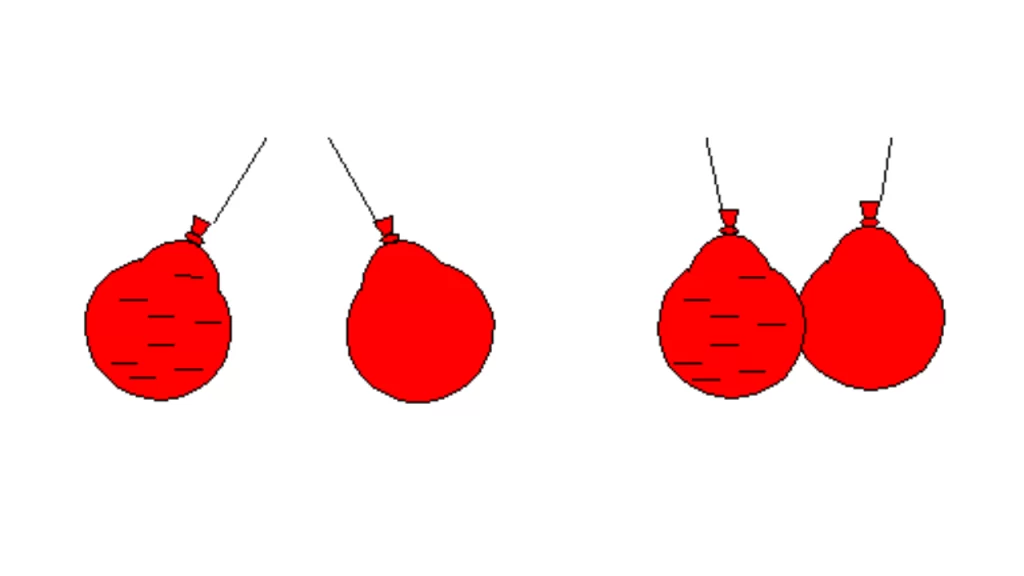
Static electricity is a phenomenon that occurs when there is an imbalance of electric charge on the surface of an object.
This imbalance can happen due to various processes, including friction, contact, and induction. Here’s how it works:
What is Friction in Electric Charge And Static Electricity:
When two materials rub against each other, electrons can be transferred from one material to the other.
The material that gains electrons becomes negatively charged, and the material that loses electrons becomes positively charged.
For example, when you rub a balloon against your hair, electrons from your hair are transferred to the balloon, leaving your hair with a positive charge and the balloon with a negative charge.
Contact:
When two objects with different charges come into contact, electrons can move from one object to the other until their charges become more balanced.
This can result in one object becoming positively charged and the other becoming negatively charged.
Induction:
Induction involves the redistribution of charges within an object without direct contact with another charged object.
When a charged object is brought near a neutral object, the charges within the neutral object can shift, causing one side to become more positively charged and the other side more negatively charged.
Static electricity is more noticeable in certain conditions, such as when the air is dry, because dry air is a poor conductor of electricity. This means that electric charges do not easily flow through the air, allowing them to accumulate on the surface of objects.
Common examples of Electric Charge And Static Electricity include:
- Getting a shock when you touch a doorknob after walking across a carpet.
- Seeing your hair stand on end when you rub a balloon against it.
- Observing sparks when you touch a metal object after shuffling your feet on a rug.
Static electricity has various applications and implications, from industrial processes to everyday phenomena like lightning during storms.
It’s important to manage static electricity in certain contexts to prevent hazards, such as the ignition of flammable materials.
Read more.
- CBSE Class 10 Basic Maths Question Paper 2020 With Solutions
- CBSE Social Science Class 10 Question Paper 2020 With Answers
- 10th Class All Subject Books Hindi Medium NCERT PDF Download
- Class 10 All Subjects Books NCERT PDF Download in English
Frequency Question FAQ Electric Charge And Static Electricity
What is electric charge?
Electric charge is a fundamental property of subatomic particles, such as electrons and protons. It is responsible for electromagnetic interactions between particles and is categorized as positive or negative.
What are positive and negative charges?
Positive charges are associated with protons, while negative charges are associated with electrons. Like charges repel each other, and opposite charges attract each other.
What is static electricity in Electric Charge And Static Electricity?
Static electricity refers to the accumulation of electric charge on the surface of an object due to processes like friction, contact, or induction. It is characterized by an imbalance of charges, resulting in attractive or repulsive forces.
How does static electricity occur?
Static electricity can occur through processes like friction, where materials rub against each other and exchange electrons. Contact between objects with different charges can also lead to static buildup. Induction involves redistributing charges within an object without direct contact.
Why is static electricity more noticeable in dry conditions?
Dry air is a poor conductor of electricity, so electric charges do not easily dissipate into the environment. This allows charges to accumulate on the surfaces of objects, leading to a greater buildup of static electricity.
